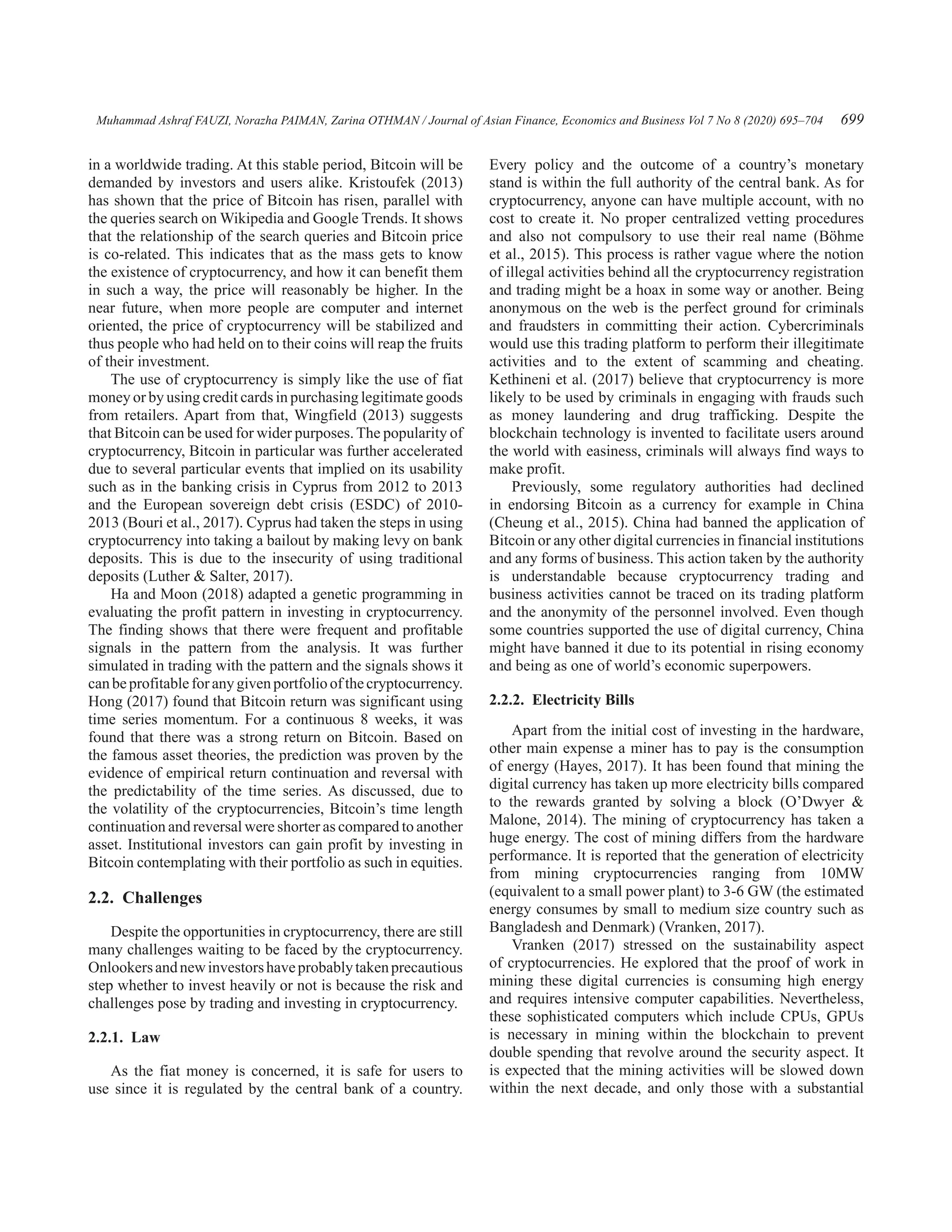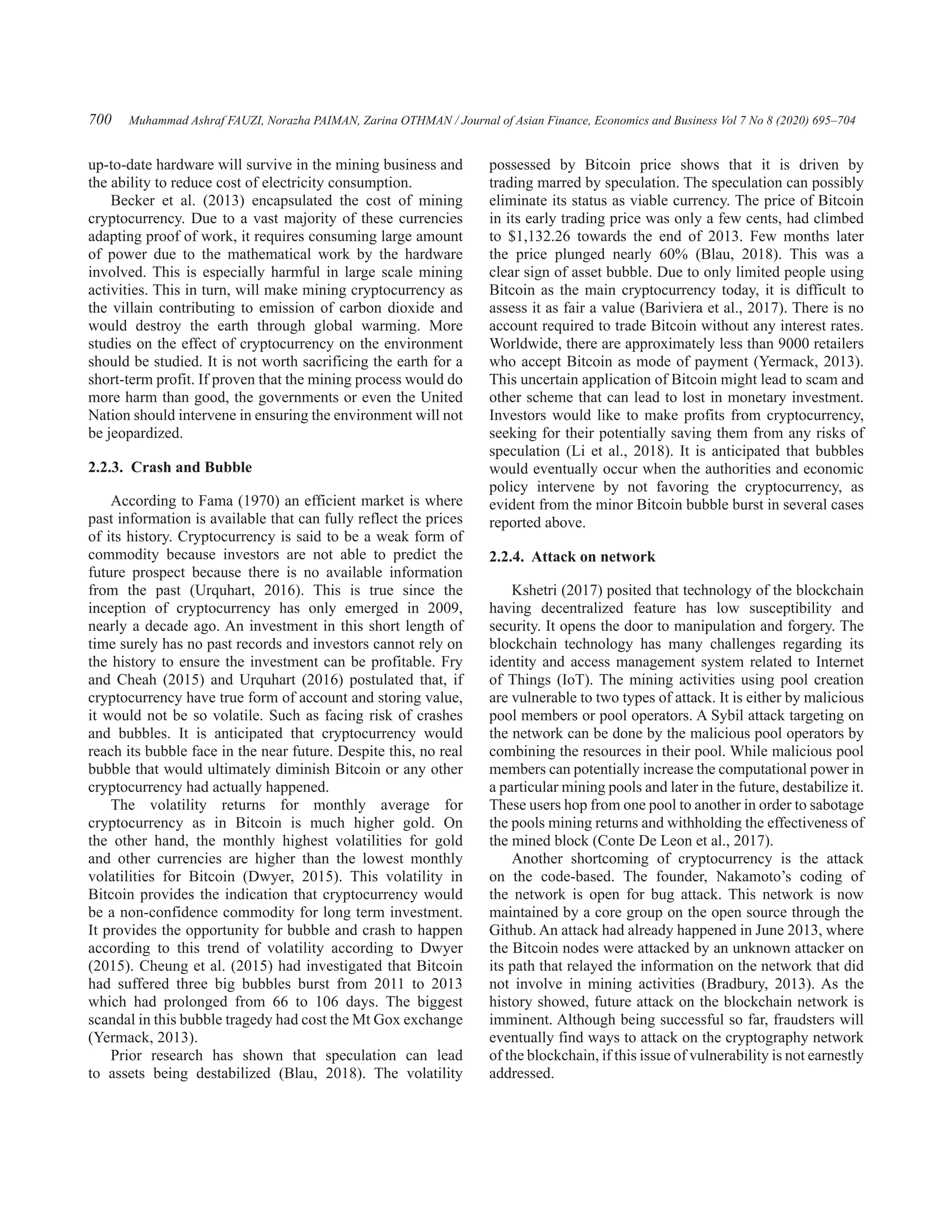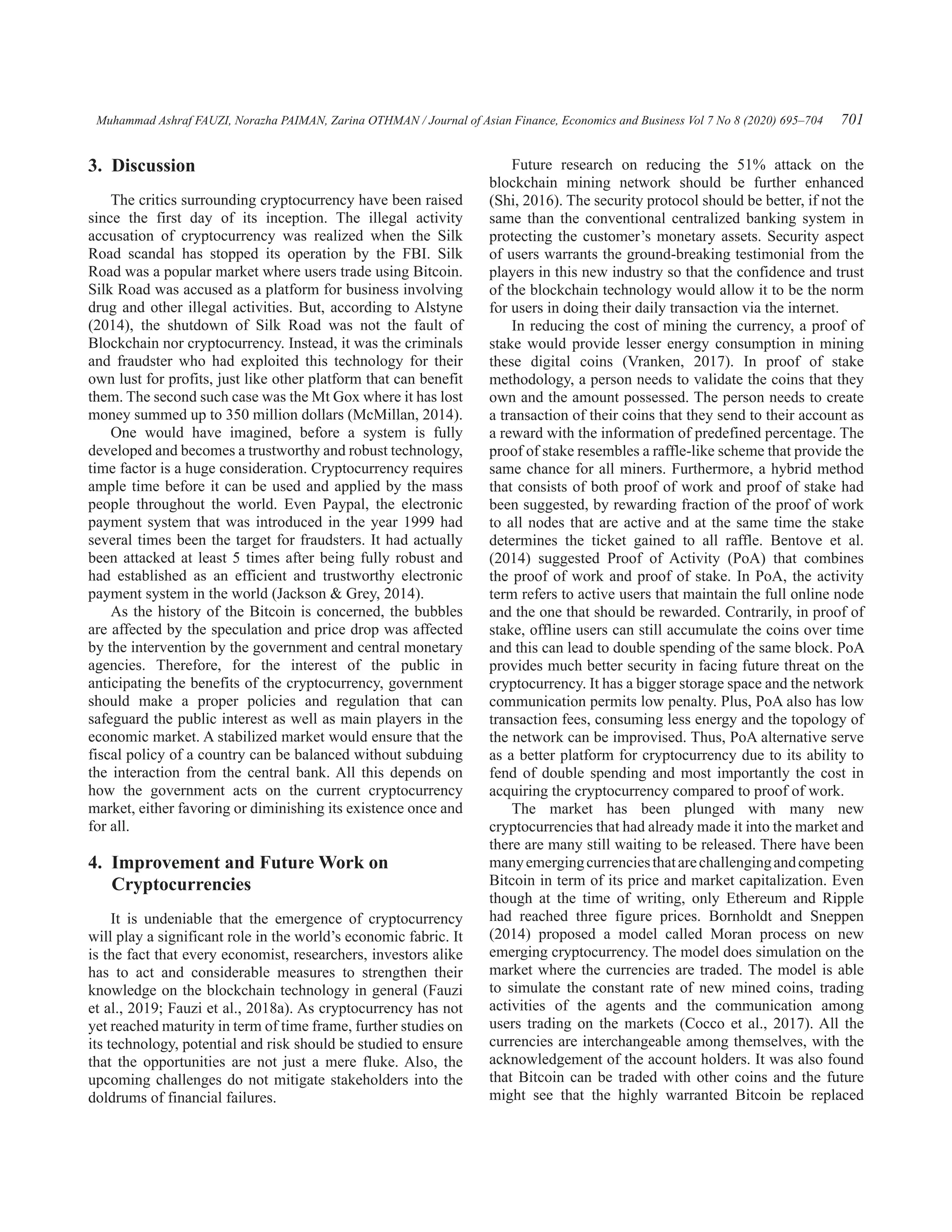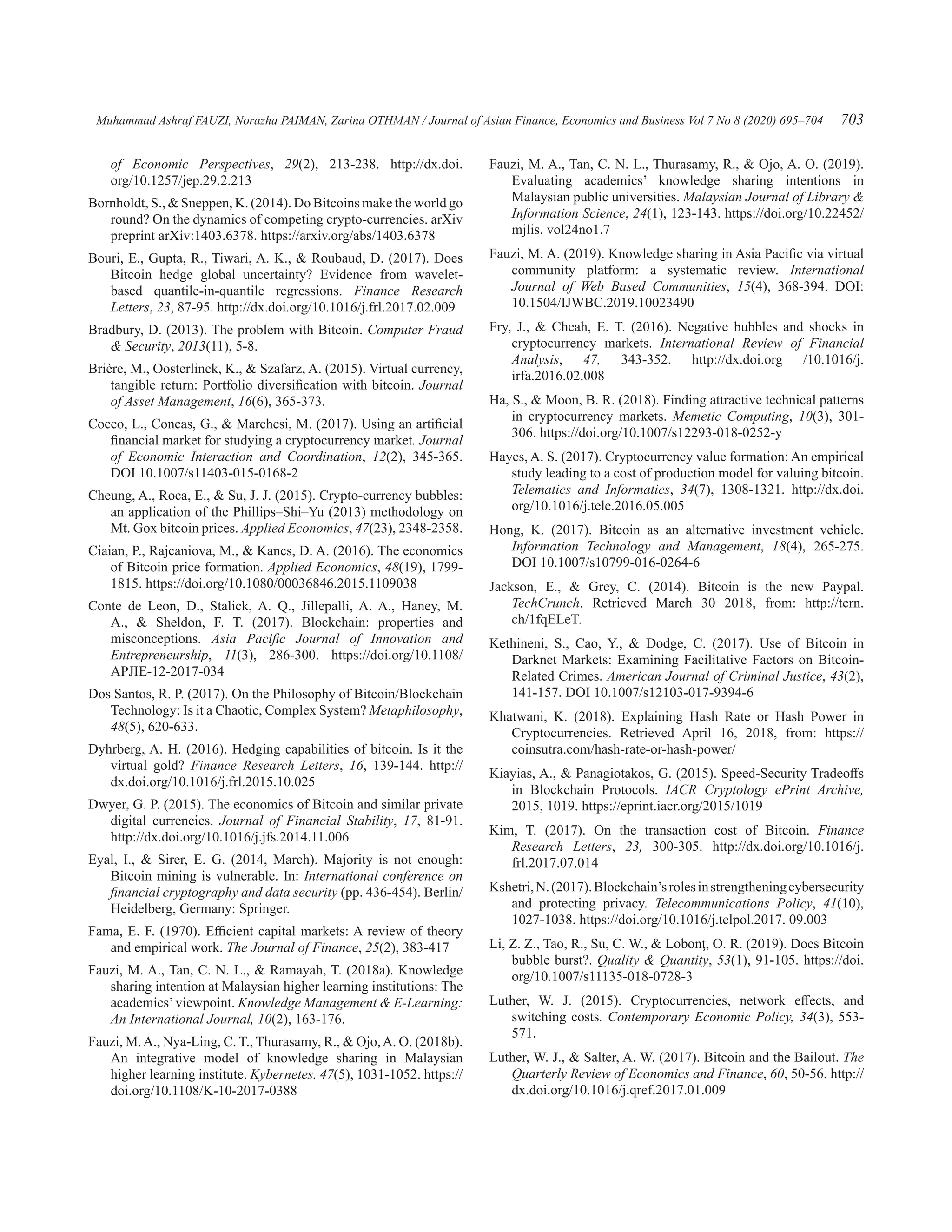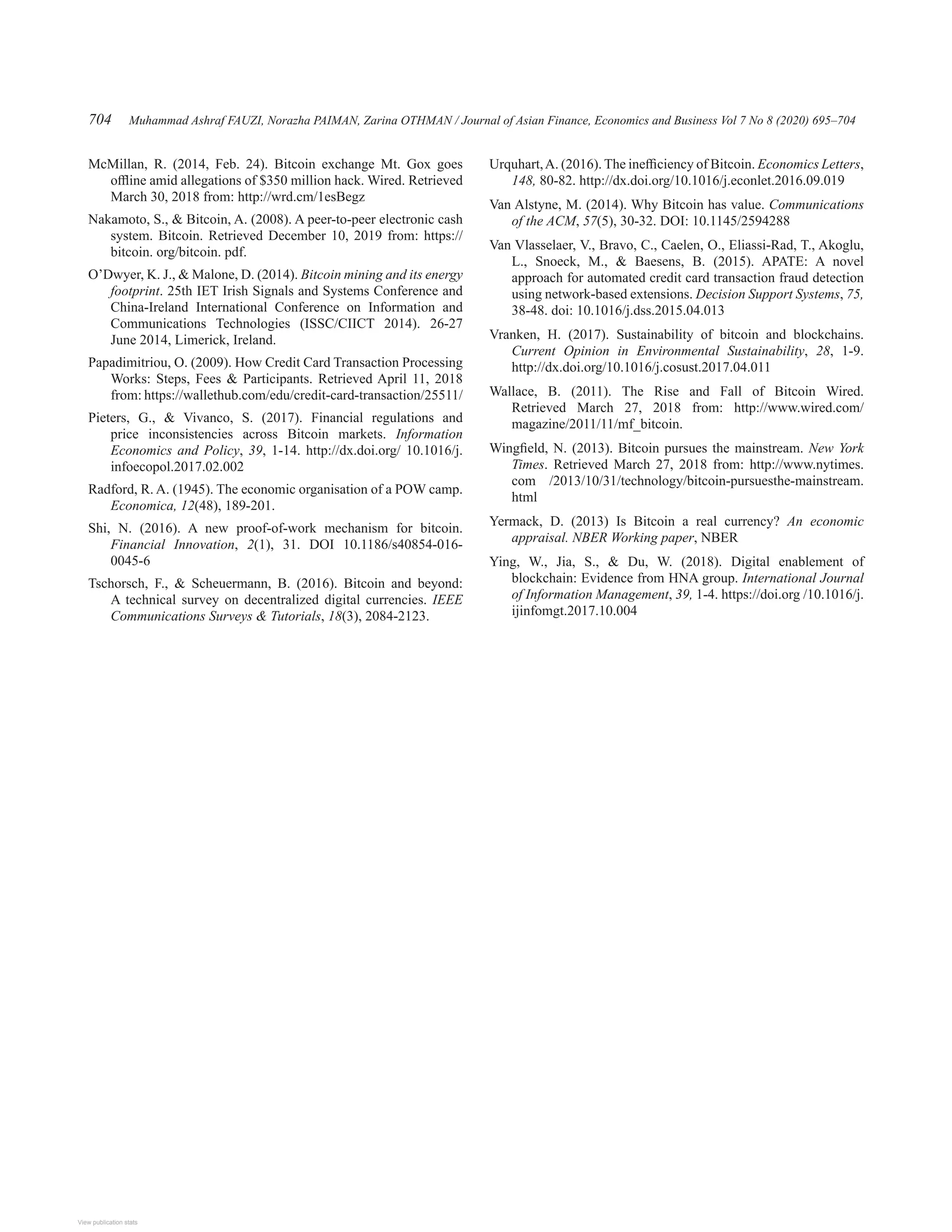The document discusses the rise of Bitcoin and cryptocurrency, highlighting their challenges, opportunities, and potential future developments. It examines the impact of blockchain technology on secure transactions, low costs, and investment returns, while also addressing risks such as lack of regulation and high energy consumption. Researchers emphasize the need for further studies to understand the complexities of cryptocurrency and its role as a potential replacement for traditional currency.

![Muhammad Ashraf FAUZI, Norazha PAIMAN, Zarina OTHMAN / Journal of Asian Finance, Economics and Business Vol 7 No 8 (2020) 695–704 695
695
Print ISSN: 2288-4637 / Online ISSN 2288-4645
doi:10.13106/jafeb.2020.vol7.no8.695
1
First Author. Senior Lecturer, Faculty of Industrial Management,
Universiti Malaysia Pahang, Malaysia.
Email: ashrafauzi@ump.edu.my
2
Corresponding Author. Lecturer, Centre for Liberal Studies,
Universiti Kebangsaan Malaysia, Malaysia [Postal Address: 43600
Bangi, Selangor, Malaysia] Email: azha@ukm.edu.my
3
Associate Professor, Centre for Liberal Studies, Universiti
Kebangsaan Malaysia. Email: zothman@ukm.edu.my
© Copyright: The Author(s)
This is an OpenAccess article distributed under the terms of the Creative CommonsAttribution
Non-Commercial License (http://Creativecommons.org/licenses/by-nc/4.0/) which permits
unrestricted noncommercial use, distribution, and reproduction in any medium, provided the
original work is properly cited.
Bitcoin and Cryptocurrency: Challenges, Opportunities and Future Works
Muhammad Ashraf FAUZI1
, Norazha PAIMAN2
, Zarina OTHMAN3
Received: April 28, 2020 Revised: July 05, 2020 Accepted: July 09, 2020
Abstract
Bitcoin and other prominent cryptocurrencies have gained much attention since the last several years. Globally known as digital coin
and virtual currency, this cryptocurrency is gained and traded within the blockchain system. The blockchain technology adopted in using
the cryptocurrency has raised the eyebrows within the banking sector, government, stakeholders and individual investors. The rise of the
cryptocurrency within this decade since the inception of Bitcoin in 2009 has taken the market by storm. Cryptocurrency is anticipated as
the future currency that might replace the current paper currency worldwide. Even though the interest has caught the attention of users,
many are not aware of its opportunities, drawbacks and challenges for the future. Researches on cryptocurrencies are still lacking and still
at its infancy stage. In providing substantial guide and view to the academic field and users, this paper will discuss the opportunities in the
cryptocurrency such as the security of its technology, low transaction cost and high investment return. The originality of this paper is on
the discussion within law and regulation, high energy consumption, possibility of crash and bubble, and attacks on network. The future
undertakings of cryptocurrency and its application will be systematically reviewed in this paper.
Keywords: Cryptocurrency, Blockchain, Mining, Investment
JEL Classification Code: E00, D80, O10, O50, P11
to reveal one’s identity for a transaction to happen. Unlike
the current practice, the bank functions as the middleman
or the go-between, knows the identity of buyer and seller,
thus engendering the issues of personal data protection.
Bitcoin platform has made the trading and transaction of
cryptocurrency much easier and more independent, without
compromising personal information and details. To some,
opting for this method of transaction has entitled them to
transact freely and anonymously.
Bitcoin is the first digital coin in the world to have used
the blockchain platform. It is created within a transaction
log with computers participated across a network (Bohme
et al., 2015). This blockchain has one of the highest security
systems by not allowing fraudsters to use the currency more
than once. The blockchain protocol rely on proof of work
where it ensures miners converge to this structure. The
computational operation is known as hashing where the term
hashing power refers to the computational power of mining
the currencies (Kiayias Panagiotakos, 2015).
The system in the cryptocurrency market is rather
complex and quite difficult to understand, even for the players
in the industry and researchers doing studies in this field
(Fry Cheach, 2016). There have been many researchers
revealing the benefits of Bitcoin such as security (Bariviera
et al., 2017), low transaction cost (Kim, 2017), high return
1. Introduction
Since the inception of the fiat money, people have been
using it for everyday transaction. Trading and transaction has
been much easier. In the year 2009, after the global crash of
2008, the first form of cryptocurrency has emerged in the
form of Bitcoin. It was first introduced by Nakamoto (2008),
an anonymous group or individual that has introduced Bitcoin
as the first digital currency for easier day-to-day transaction
from individual to individual. Bitcoin is operated without
the middle man such as banks and monetary institutions.
It is a form of peer-to-peer transaction, without the need](https://image.slidesharecdn.com/2020-jafeb-210909095100/75/Bitcoin-Desk-Clock-2-2048.jpg)



